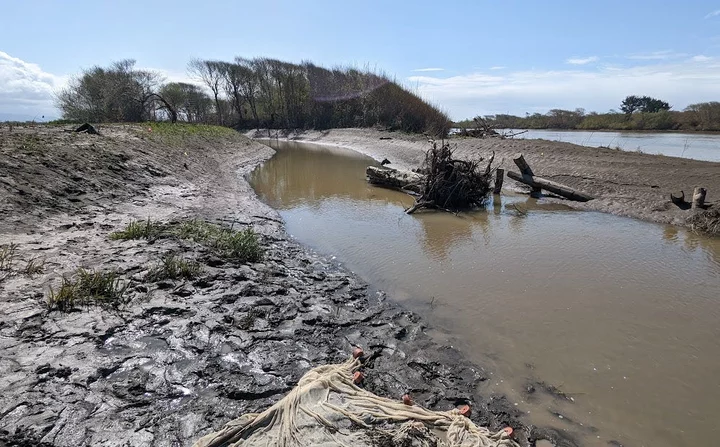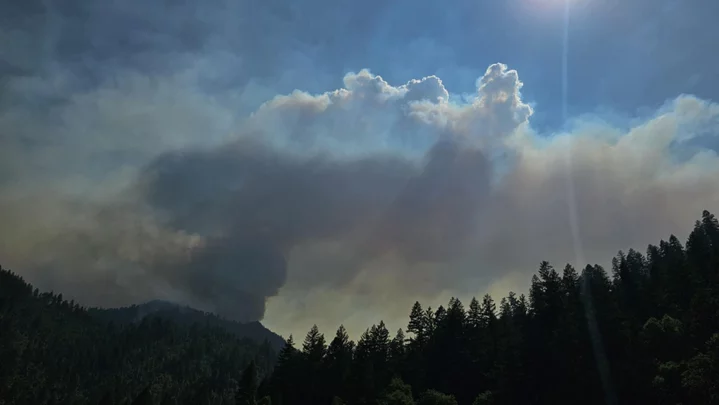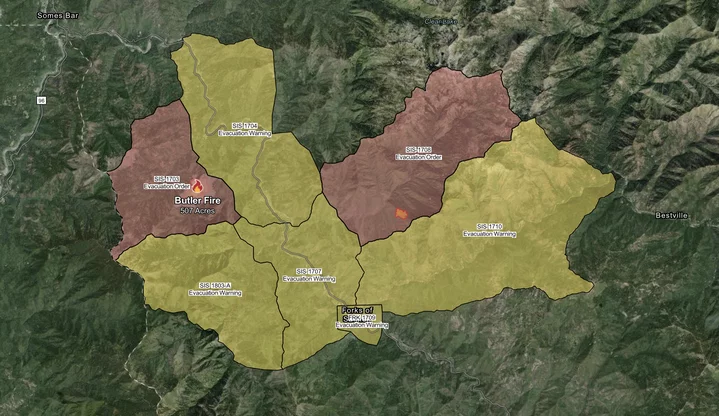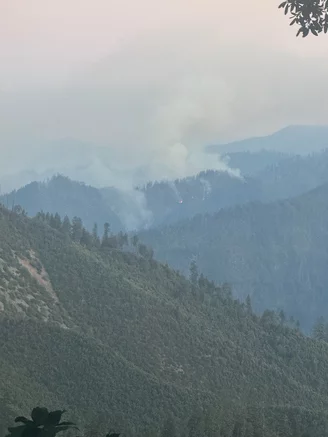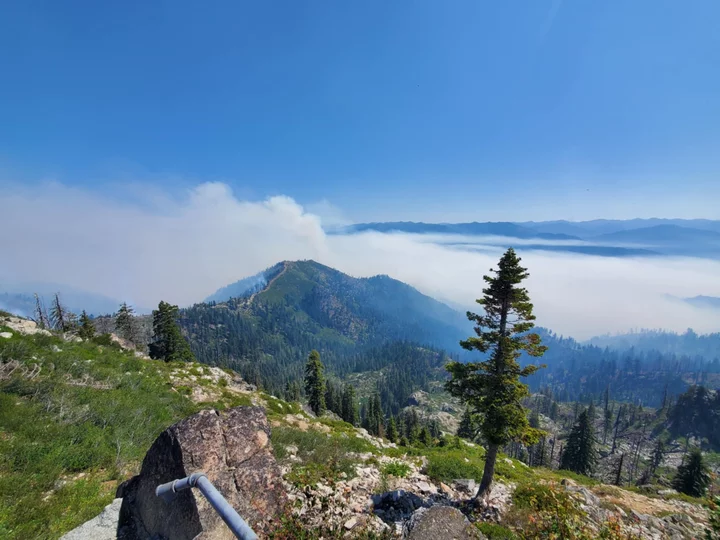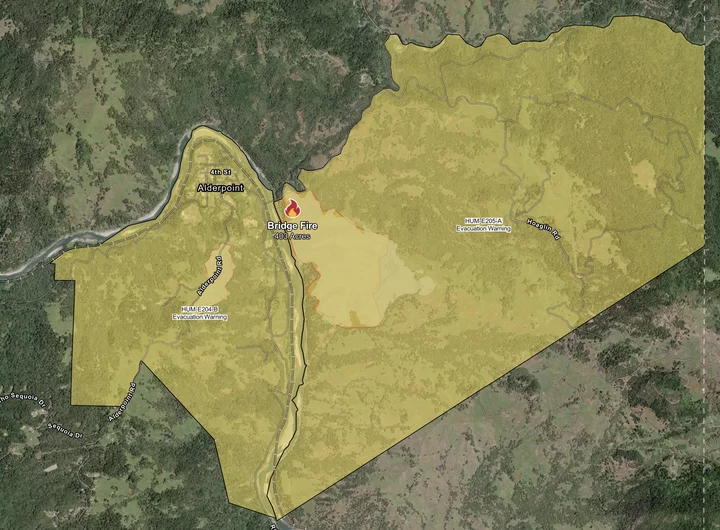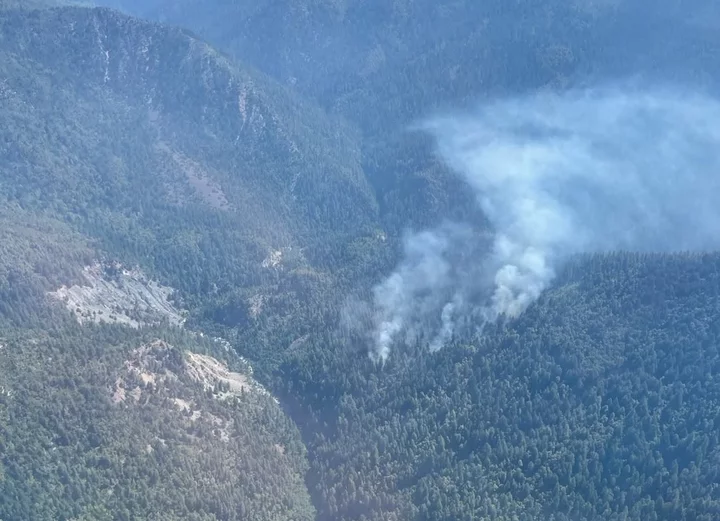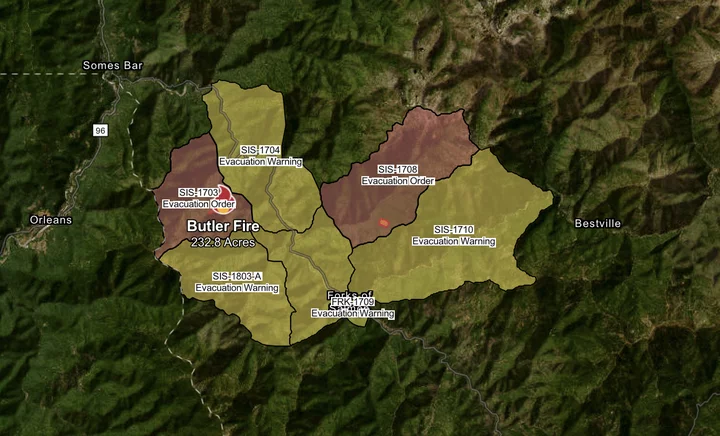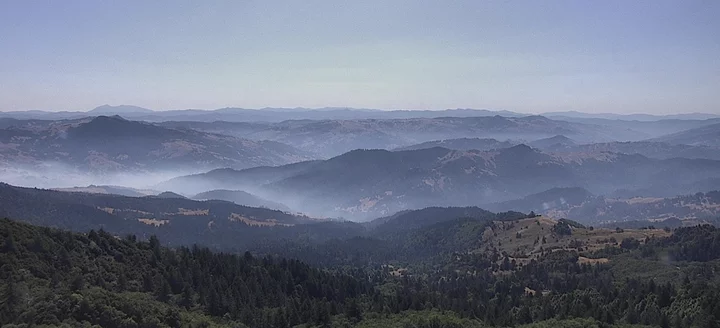Fish are Absolutely Loving This Recent Improvement to the Mad River Estuary, According to New Cal Poly-Led Study
LoCO Staff / Tuesday, July 8 @ 1:03 p.m. / Wildlife
Baduwa’t estuary? More like GOODuwa’t estuary, if you’re a fish! Photo: Colton Dixon.
Press release from Caltrout:
California Trout (CalTrout) announced today that the Baduwa’t (Mad River) estuary restoration project has been successful in providing natural habitat to numerous threatened species, according to new monitoring data. The 9.3-acre project, designed by Northern Hydrology and Engineering, and completed in partnership with McKinleyville Community Services District in late 2022, transformed former wastewater percolation ponds into floodplain habitat that is now successfully supporting a thriving ecosystem.
“These monitoring results prove that strategic habitat restoration works,” said Mary Burke, CalTrout’s North Coast Regional Manager. “The Baduwa’t restoration project site is providing some of the only refugia habitat for fish to escape from high winter flows in the estuary. We were especially excited to learn that coho salmon have utilized the site every winter since construction.”
Post-restoration monitoring conducted by Dr. Darren Ward at California State Polytechnic University Humboldt reveals the site is functioning exactly as scientists hoped. CalTrout hired Ward’s crew for post-project monitoring, building on a long-term partnership through which Ward brought students to sample the site regularly since before construction, allowing researchers to document the ecosystem change before and after restoration.
The monitoring shows Chinook and coho salmon have occupied the restored area every year since construction, with young salmon following their natural life cycle and pausing their journey to the ocean to eat and grow rapidly in the protected waters. Fish occupying the site have growth rates as fast or faster than similar restoration projects and significantly faster than fish remaining in their birth streams. Notably, coho fry younger than one year are about 20% longer than the ones outside the pond. The site supports juvenile salmonids with winter habitat and a critical stopover in their migration corridor, with increased numbers of smolts using the area during their spring ocean migration.
Throughout 25 sampling events from January 2023 to May 2025, researchers documented more than 15,500 individual fish representing 17 different species at the restoration site. The vast diversity of species included threatened Chinook and coho salmon, threatened steelhead trout, state species of special concern coastal cutthroat trout, and endangered tidewater goby.
“It has been an amazing opportunity to follow along with the CalTrou project from the initial planning stages to follow-up monitoring after implementation,” said Dr. Darren Ward, Department of Fisheries Biology Professor at Cal Poly Humboldt. “CalTrout’s funding for monitoring allowed me to hire a crew of students for field work, providing critical work experience as they start their careers.”
The success demonstrates that reconnecting rivers to their floodplains can rapidly restore ecosystem function, creating habitat that supports salmon, marine species like bay pipefish and starry flounder, and also serves as an introduction for the next generation of restorationists. For more information about the Baduwa’t estuary restoration project and more of CalTrout’s restoration work on the North Coast, click HERE.
About California Trout
California Trout is a nonprofit conservation organization dedicated to revitalizing waters for resilient wild fish and a better California. Through science-based advocacy, restoration and community engagement, CalTrout protects and restores the state’s freshwater ecosystems for fish and people alike.
Learn more at caltrout.org.
BOOKED
Today: 15 felonies, 9 misdemeanors, 0 infractions
JUDGED
Humboldt County Superior Court Calendar: Today
CHP REPORTS
Us101 (HM office): Traffic Hazard
10040 Mm101 S Hum 100.40 (HM office): Trfc Collision-Unkn Inj
Us101 N / Pepperwood Ofr (HM office): Trfc Collision-1141 Enrt
ELSEWHERE
RHBB: Major Injury Crash on State Route 20 Stops Traffic in Both Directions
RHBB: Butler Fire Surges Across Salmon River, Threatens Forks of Salmon
RHBB: Coast Guard Provides Details on Rescue of 11-Year-Old Girl from Surf at Big Lagoon
WILDFIRE ROUNDUP: Butler Fire Quadruples in Size to 966 Acres, With No Containment; Minimal Growth Reported on Bridge and Red Fires
Isabella Vanderheiden / Tuesday, July 8 @ 10:58 a.m. / Fire
Morning view of the Butler Fire burning at the Humboldt-Siskiyou county line. | Photo: Abel Mattson - Orleans Patrol 25.
Butler Fire — Siskiyou County
The Butler Fire has quadrupled in size in the last 24 hours, growing from 233 acres to 966 acres with no containment. The fire is burning approximately 10 miles northeast of Orleans, near Butler Mountain above Salmon River Road.
There is a mandatory evacuation order in place for zones SIS-1703 and SIS-1708 in Siskiyou County. There are evacuation warnings in place for zones SIS-1704 (Butler Creek, Lewis Creek and Bloomer Mine), SIS-1707, SIS-1710 and SIS-1803-A. Nordheimer and Oak Bottom campgrounds are currently closed for fire suppression activities. Click here for an interactive map of current evacuation orders.
A map of evacuation orders and warnings for the Butler Fire. | Screenshot
The following additional information comes from the Six Rivers National Forest:
Leader’s Intent: The Butler Fire is being managed with a full suppression strategy emphasizing firefighter and public safety while protecting critical values at risk.
Operational Update: Today the Butler and Nordheimer Structure Groups will continue to focus on implementing their structure protection plans, with a strong focus by Butler Structure Group on the Butler Flat Community’s water system infrastructure. Along Salmon River Road, crews will begin to complete roadside brushing activities as well as continue to prepare the lower section of the Boundary/Orleans Trail to connect to the work done by crews along the ridgeline.
Crews have been working tirelessly to contain this fire. IR flight data reports that yesterday the fire doubled in size, making today’s response efforts critical to minimize continued growth. Crews on the ground and aircraft will begin the day by assessing how the line held overnight and engage quickly where it is safe to do so. Helicopters will be dropping water on critical locations as conditions allow. Crews will also engage on the spot fires near the boundary ridgeline in the headwaters of Hammel Creek. Since the fires began on the ridgetop, the ideal situation is to back the fire down with low intensity from the ridge down towards the Lewis Creek drainage. The goal is to continue to fully suppress the fire with all means possible, going direct on the Boundary/Orleans Mountain Trail and utilize air resources to tame critical hotspots.
The Incident Command Post will remain at the Orleans District Office with base camp located at the Oak Bottom Campground.
One prescribed burn and one cultural burn are planned to occur today. Both of these actions are separate from the Butler Fire incident management. The Mid Klamath Watershed Council (MKWC) and partners plan to move forward with the All Hands All Lands Butler Rx plan to burn 6 acres at Butler Flat Meadow at approximately 4 p.m. This is independent from the Butler Fire, and they provide all their own resources and plans. If there are questions or concerns, please contact MKWC Fire and Forestry Program at 530- 627-3202. A Cultural burn may also occur directly across the creek from the All Hands All Lands prescribed fire.
View from Orleans Mountain lookout. | Photo: James McLaughlin - Orleans Crew 20
Community Meeting: There will be a community meeting about the Butler and Red Fires Wednesday, July 9 at 5 p.m. at the Karuk Department of Natural Resources located at 39051 Highway 96 in Orleans. For those unable to attend in person, a recording will be available on Facebook after the meeting.
Closures & Evacuations: Siskiyou County Sherriff have evacuations warnings and orders in place for the Butler Fire. As Evacuation Order has been issued for SIS-1703 (no residents). Warnings apply to zone SIS-1704 (Butler Creek, Lewis Creek, Bloomer Mine residents and Nordheimer Campground), SIS-1707, and SIS-1803-A (no residents). There are no planned road closures along Salmon River Road. However, the public may experience minor delays as crews work on roadside brushing over the next few days. Nordheimer and Oak Bottom Campgrounds are closed due to wildfire and fire suppression activities.
Weather & Fire Behavior: Local weather will be warm (high 80s) and slightly breezy today (southwest winds 5-8 mph). Relative humidity remains around 50% to 60%, which may help moderate fire behavior despite warm, breezy conditions.
Fire Safety & Prevention: The local area is likely to have both wildfire suppression operations and external prescribed and potentially cultural burning today. These operations are being done with care and consideration for firefighter and public safety. Area residents and visitors should be aware of their surroundings, watch for increased traffic in the area and try to avoid being in the fire area. With this activity and the issuance of evacuation warnings, residents and visitors should review resources at www.siskiyoucounty.gov/ReadySiskiyou.
Fire Information: For additional fire information and resources, please visit www.linktr.ee/srffirepio.
The Marble Complex and Jacket fires continue to burn further east. As of this writing, the Marble Complex Fire is at 445 acres and five percent containment, and the Jacket Fire is holding at 50 acres with five percent containment.
###
A map of evacuation warnings for the Bridge Fire. | Screenshot.
Bridge Fire — Humboldt County
Fire crews have made significant progress on the Bridge Fire, which ignited near Alderpoint on Sunday evening. The fire, burning on either side of the Eel River, has grown by about 55 acres in the last 24 hours, to 403 acres with 30 percent containment.
There are 300 fire personnel currently assigned to the fire, along with 45 engines, one dozer, nine crews and seven water tenders.
“Firefighters continue to strengthen the perimeter on two vegetation fires burning on opposite sides of the Eel River, in grass, brush, and timber,” according to CalFire.
An evacuation warning is still in effect for residents in zones HUM-E204-A and HUM-E204-B. A previous notification on Watch Duty, a volunteer-contributed fire information resource, indicated that the evacuation warning was lifted on Monday, but that does not appear to be the case. An interactive map of current evacuation notices can be found here.
###
Aerial view of the Red Fire via Six Rivers National Forest.
Red Fire — Del Norte County
The Red Fire, which ignited on Sunday, has burned 28 acres east of Klamath Glen with no containment. There are no evacuations in place at this time. The following additional information comes from the Six Rivers National Forest:
Firefighters are continuing to respond to the Red Fire burning in the Siskiyou Wilderness on the Six Rivers National Forest Orleans Ranger District.
The fire is approximately 28 acres and is located about 1.5 miles north of Nickowitz Peak near Blue Creek. Cause is under investigation and there is no containment. There are no structures or communities threatened.
The Red Fire is burning in heavy fuels and dense vegetation with moderate fire behavior. The fire growth from 3 acres to approximately 28 acres today was driven by steep terrain and winds.
Smokejumpers and rappelers were fighting the fire today after arriving on scene this morning. Aviation resources have been working on suppressing the fire throughout the day.
While firefighters are working on fighting the Red and Butler Fires on the Six Rivers National Forest, as well as supporting incidents throughout Northern California, the public is asked to use caution with anything that can spark a fire.
California Wants New Education Requirements for Police Officers. Are They Watered Down?
Cayla Mihalovich and Adam Echelman / Tuesday, July 8 @ 7:12 a.m. / Sacramento
Photo: Michael Patrick’, via Flickr. CC BY-NC-ND 2.0 license.
###
This story was originally published by CalMatters. Sign up for their newsletters.
###
Amid calls for police reform in the aftermath of George Floyd’s murder in 2020, California lawmakers set out to raise education standards for incoming law enforcement officers. Five years later — as California faces a widespread shortage of police officers — those reforms are being debated once again.
In 2020, former Assemblymember Reggie Jones-Sawyer introduced a bill that would have required prospective police officers 18 to 25 years old to earn a bachelor’s degree before entering the police force. A growing body of research shows that college-educated law enforcement officers tend to use less force and exercise better decision making.
The bill was ultimately revised after it was criticized as too restrictive by law enforcement and labor leaders. In an updated version, which was signed into law the following year, lawmakers agreed to raise the minimum age of a police officer to 21 years old, and they asked local police and school officials to create recommendations for new higher education requirements.
This year, Assemblymember Jacqui Irwin, a Democrat from Thousand Oaks, is proposing a new bill to establish education standards based on those recommendations, but some law enforcement and criminal justice reform advocates are skeptical — albeit for different reasons.
Starting in 2031, Irwin’s new law would require incoming officers to get a policing certificate, associate degree or bachelor’s degree, although there are some exceptions within 36 months of graduating from a police academy. It also creates a law enforcement recruitment task force to identify and recruit candidates for law enforcement agencies throughout the state.
In an interview with CalMatters, Jones-Sawyer said the current bill by Irwin undermines the original intent behind his 2021 law by allowing a loophole for incoming officers to satisfy the education requirement through a certificate, prior military experience or out-of-state law enforcement experience.
Some policing experts, such as former justice department official Arif Alikhan, echoed those concerns and said the exceptions swallow the whole. “It completely obviates the need to have any educational background,” said Alikhan. “Officers who have a college education tend to perform better.”
Representatives from some law enforcement unions, by contrast, think the bill still goes too far. Dustin Smith, president of the Sacramento Police Officers Association, said the new requirements “would be catastrophic to staffing statewide,” limiting the supply of incoming officers.
Those concerns haven’t stopped the bill from sailing through the Legislature, where it has received widespread support from many law enforcement agencies. It’s supported by all of California’s statewide law enforcement advocacy groups, including the California Police Chiefs Association, the California State Sheriff’s Association, the California Association of Highway Patrolmen and the umbrella labor organization that lobbies on behalf of police unions, the Peace Officers Research Association of California. It has received no formal opposition.
Democratic lawmakers at odds with one another over new standards
In introducing his bill, Jones-Sawyer viewed a college education as paramount to law enforcement training because it would expose incoming officers to new perspectives, healthy debate and critical thinking skills.
“We keep looking at law enforcement as if anybody can do it,” said Jones-Sawyer. “No. You need a certain type of person to have the skills and ability to deal with modern-day policing.”
Instead of requiring an associate degree in modern policing, as Jones-Sawyer said he intended, the new bill allows incoming police officers to meet the education standards with four years of military or out-of-state law enforcement experience. While Jones-Sawyer intended to carve out certain exceptions for people with prior specialized military or law enforcement experience, they would have only been given some credit – not all.
New officers also have the option of attaining a “professional policing certificate” from an accredited college or university, although that curriculum has not yet been developed.
The new bill “does not make policing better, it makes it devolve back into what it used to be,” said Jones-Sawyer. Irwin maintained that the bill advances his efforts and will help police officers improve themselves as they rise through the ranks.
Many police chiefs and sheriffs view the bill as a meaningful way to raise education standards while affording incoming officers the flexibility to meet them.
In May, Los Angeles Sheriff Robert Luna wrote a letter to Sen. Jesse Arreguín, an Oakland Democrat and chair of the Senate’s public safety committee, arguing in favor of Irwin’s bill. The sheriff’s office once required all applicants to have a bachelor’s degree, wrote Luna, but the requirement was “short-lived” because the office saw “an immediate decline in applicants by about 50 percent.”
Luna said Irwin’s bill is a “more workable, more inclusive path forward” because it includes exceptions for those with non-academic experience.
Although the vast majority of local law enforcement agencies nationwide only require a high school diploma, having a college degree can often create more opportunities for better pay and promotions.
Police officer shortage: truth or myth?
All across the state, law enforcement officials say staffing is an ongoing problem, which more education requirements might exacerbate. The Los Angeles County Sheriff’s Office is short roughly 1,500 officers as of June 1, according to spokesperson Miesha McClendon. The office was able to respond to recent protests through the support of staff from other areas of law enforcement, including its jails and detective division, McClendon said.
In rural areas, such as Plumas County in the northeast corner of the state, Undersheriff Chad Hermann said a single officer is sometimes responsible for covering communities that are as far as 70 miles apart. If that officer needs to make an arrest and drive a suspect to jail, a town could spend hours without any nearby police on duty, he said.
Sheriffs and police officers say the shortage is due to several factors, including low wages in some communities, an aging workforce and negative perceptions of police following high-profile instances of misconduct. Departments are offering starting bonuses and other incentives, such as better benefits, as a way to recruit new officers.
Some agencies gave record-breaking raises to officers coming out of the COVID-19 pandemic. In some places, including the California Highway Patrol, entry-level officers can expect six-figure salaries and top notch benefits.
But not all agencies can offer those perks.
“We’re not a rich county — we can’t offer the big hiring stipends,” said Hermann. “By adding a requirement like an associate degree, it’s going to make it harder to get people from our hiring pool.” He said even exceptions for those with military service may not help the recruiting problem since the hiring pool is so small in a county with just under 19,000 residents.
While the new law enforcement recruitment task force in Irwin’s bill is designed to ease some of those staffing challenges, Christy Lopez, a law professor at Georgetown University said it’s troubling to see that it would only comprise people from law enforcement.
“We need to be moving towards a recruiting approach that seeks to screen in the right people, not just screen out the worst people,” she said. “And to make sure that we develop that sort of approach to recruiting, you need perspectives broader than just law enforcement.”
She said the police recruiting crisis is a myth. “The idea that there’s a crisis in recruiting presupposes that we know what the right number of police officers is and that we’re not there,” she said. “And we don’t know that.”
What it takes to become a police officer
Devin Nisbet grew up in Calaveras County and as a kid, he had a positive experience with one of the officers when he prank-called 9-1-1. Instead of just disciplining Nisbet, who was around 6 years old, the officer gave him a tour of the police cruiser and handed him a patch with the sheriff’s office logo. “It made me want to be part of it,” said Nisbet in an interview with CalMatters.
After dropping out of college, Nisbet was working for a grocery store in Calaveras County when that same sheriff’s office held a recruiting event in a nearby parking lot. The agency promises a $10,000 bonus, spread out over three years, for new recruits. At the time, he said he thought to himself, “Why not try to do this?”
It took Nisbet roughly seven months to pass the county’s background checks and exams, which include a written test, a psychological exam and a medical exam. He then received a tentative job offer from the Calaveras County Sheriff’s Office, contingent on completing a police academy.
In January, he enrolled in the police academy at San Joaquin Delta College in Stockton. Police academy training in California typically takes a minimum of six months, but some police departments require far more training. Nisbet is paid by the Calaveras County Sheriff’s Office for the entirety of this training, just under $34 an hour.
The college program requires students to learn CPR, first aid, and various laws about use of force, search and seizure and firearms. They’re tested in scenarios that can include chases or combat. In one timed exam, they must pull a 165 lb dummy, cross a 25 yard obstacle course, run 500 yards and scale a 6-foot fence.
Some students fail to pass the academy’s courses. Others never get hired because they fail the police department’s background checks or have low scores.
Nisbet is set to graduate on July 2, at which point he’ll begin working, but his training won’t be over. New officers must complete weeks of field training and a year of probation.
“I believe that people, if they want to do this job, they need to get evaluated first,” said Nisbet, though he said an associate degree shouldn’t be required. He said many of his classmates don’t have a college degree.
OBITUARY: Lauren Jill Miner, 1963-2025
LoCO Staff / Tuesday, July 8 @ 6:56 a.m. / Obits
Lauren Jill Miner
Eureka,
Calif.
February
4, 1963 – June 7, 2025
Lauren Jill Miner, 62, of Eureka, passed away in her home on June 7, 2025 after a long battle with chronic illness.
Lauren was born at General Hospital in Eureka on February 4, 1963 to Richard “Bruce” and Shirley J. Miner. Lauren attended primary and secondary schools in Eureka, graduating from Eureka High School in 1981, and eventually earning a Bachelor of Arts in English from California State University Humboldt. During her school years Lauren developed a love of music and theater, performing on woodwinds in various ensembles during the 1980s and 1990s.
Since her teen years, Lauren was an active member of the First Presbyterian Church of Eureka. She found a love for singing and became a regular member of her church choir, adding her robust voice to the tenor section. This experience led to her association with the California Redwoods Chorale, a community mixed chorus that made several concert tours abroad. Like her mother Shirley she was an active member of community service organizations, including PEO (Philanthropic Educational Organization), which provides scholarship opportunities for women entering college or continuing their education later in life.
Lauren’s professional life varied over the years: she sold residential flooring in Sacramento, and seafood at WinCo in Eureka, but was most fulfilled later in life after going back to Cal Poly Humboldt and earning a teaching credential. She spent the latter years of her working life as a substitute teacher and Speech Therapy facilitator for Eureka City Schools.
Lauren is preceded in death by her mother, Shirley Jean Miner of Eureka, and her longtime partner and love of her life, Tony Smith of Ashland, Oregon. She is survived by her father, Richard Bruce Miner, her brother, Douglas (Rhonda) of Bremerton, WA; nephews, Andrew and Ryan Miner of Bremerton, Wash.; niece Jessica Lynn Nourouzee (Easa) and grand-nephews Simon and Elton Nourouzee of Lisbon, Portugal. She is also survived by cousin Lynn (Ernie, deceased) Schorno of Carmichael, Calif.
The family sends heartfelt thanks and appreciation to all the wonderful friends, neighbors and fellow members of her church family who helped Lauren over the past several years. A celebration of Lauren’s life will be held at First Presbyterian Church 819 15th St. Eureka, on August 23 at 1 p.m.
###
The obituary above was submitted on behalf of Lauren Miner’s loved ones. The Lost Coast Outpost runs obituaries of Humboldt County residents at no charge. See guidelines here.
CHP Corrects the Record on Last Week’s Incident Involving a Local Man Being Bitten by an Injured Bear
Isabella Vanderheiden / Monday, July 7 @ 4:42 p.m. / Traffic
###
As it turns out, the man who was bitten by the injured black bear on Highway 299 last week was not the same driver who injured the animal in the first place.
California Highway Patrol Sgt. Caleb Carey contacted the Outpost this afternoon to correct some “partially incorrect” information that was provided to us last week by a spokesperson with the California Department of Fish and Wildlife (CDFW). Carsey said he had “reached out to CDFW to ensure they were disseminating the most accurate information possible,” but there was an apparent miscommunication.
“The party that was injured by the bear was not the driver who struck the bear. He was simply a passerby who stopped and attempted to assist the injured animal,” Carsey wrote via email. “I bring this up only because he is clearly very passionate about bears, and I fear he’ll be offended by statements that he hurt one.”
At this point, Carsey said investigators can only speculate that the bear was injured in the vehicle collision, adding that there “appears to be no other plausible mechanism of injury.”
“[N]o physical evidence was located on scene to suggest a vehicle was involved, no leads were discovered to investigate, and no one has come forward to admit their involvement,” he said. “As such, we have closed our investigation into the incident.”
Asked about the current condition of the 59-year-old man who was bitten by the bear, Carsey said he hadn’t spoken to him since the day after the incident, at which point he was still “hospitalized due to his injuries.” He added that the man was only bitten once, not “multiple times,” as previously reported.
Beloved McKinleyville Log Stolen
LoCO Staff / Monday, July 7 @ 4:14 p.m. / Feel Sad
Come home, wood | McKinleyville Community Service District
McKinleyville Community Services District release:
This natural sculpture centerpiece at the Botanical Garden in Hiller Park has recently gone missing. It was last seen before the July 4th weekend and its disappearance was noticed shortly after.
This unique piece has been a special part of the garden, and we’re hoping someone in the community may know what happened to it.
If you have any information about its whereabouts, please contact the McKinleyville Parks & Recreation Department. Thank you for helping us keep our parks beautiful and welcoming for all!
FIRE UPDATE: Butler Fire Grows to 233 Acres With Zero Containment, Prompting Mandatory Evacuations; Evacuation Warnings Lifted for Bridge Fire Near Alderpoint
Isabella Vanderheiden / Monday, July 7 @ 11:42 a.m. / Fire
View of the Butler Fire from Orleans lookout. | Photo: Six Rivers National Forest
###
Northern California fire crews are responding to two wildfires burning along the Humboldt County line — the Butler Fire near Forks of Salmon in Siskiyou County and the Bridge Fire near Alderpoint. The following fire updates are current as of this morning.
Butler Fire
The Butler Fire, which ignited near Forks of Salmon during a lightning storm on Thursday evening, has grown to 233 acres with no containment. There are 73 fire personnel assigned to the fire, including four crews, four engines and two helicopters, with a fixed wing on order.
There is a mandatory evacuation order in place for Siskiyou County residents living in SIS-1703 and SIS-1708. There are evacuation warnings in place for SIS-1704, SIS-1707, SIS-1710 and SIS-1803-A. Click here for an interactive map of current evacuation orders.
A map of evacuation orders and warnings for the Butler Fire. | Screenshot
The following information comes from the Six Rivers National Forest:
Leader’s Intent: The Butler Fire is being managed with a full suppression strategy emphasizing firefighter and public safety.
Operational Update: Last night, hotshot crews successfully conducted 2 miles of defensive firing operations using pre-existing line, trails, and rock features to remove unburnt fuels below the ridgetop Boundary and Orleans Mountain Trails to secure line and hold the fire within the Lewis Creek drainage. Conditions were favorable for operations that assisted in meeting containment objectives without putting firefighters and critical values at risk.
The daytime marine influence moderated fire behavior and gentle evening winds pushed fire back down into Lewis Creek drainage. This operation helped protect the ridgeline from high-severity fire by reducing fuels up to 20 feet from the ridgetop in brush and 100 feet in timber. Conditions permitting, firefighters may continue to use nighttime defensive firing operations in coming days to help strengthen fire lines and moderate fire behavior.
Using firing operations and pulling back to natural barriers, such as the pre-existing containment features from previous fires, ridgetops, trails, roads, and rivers may increase fire size, but greatly reduces engagement risks. Firefighter and public safety remain the highest priority. Incident leadership is also committed to minimizing fire size and will be applying full suppression tactics.
Today, Nordheimer and Butler Structure groups will continue with structure protection. Orleans Mountain Lookout protection will also be a key focus. Crews plan to scout and prep from Nordheimer Campground up to the Boundary and Orleans Mountain Trails to link up with crews holding last night’s progress on the ridgetop. Until yesterday, air resources had been shared with other incidents across the north state, but the Butler Fire secured 2 helicopters for full-time air operations.
Strategic Objective: The Butler Fire is currently burning in a remote location through steep terrain (slopes up to 90%) riddled with snags and heavy brush. The area also holds considerable value to the local community. Access to the fire area is extremely difficult. There are no direct roads to the fire, and the sole ingress-egress for the communities of Forks of Salmon and Somes Bar and firefighters is the Salmon River Road. Leadership is strategically adapting tactics as weather and fire conditions evolve.
Closures & Evacuations: An Evacuation Order has been issued for SIS-1703 (no residents). Warnings are now in place for zone SIS-1704 (Butler Creek, Lewis Creek, Bloomer Mine residents and Nordheimer Campground), SIS-1707, and SIS 1803-A (no residents). There are currently no planned road closures or delays along Salmon River Road. However, local residents are advised to slow down and use caution with the increased firefighter presence in the area. Despite the Evacuation Warning, Nordheimer Campground remains open. Campers should monitor the situation and be prepared for conditions to change.
Weather & Fire Behavior: There is a 20% chance of dry thunderstorms this afternoon. Temperatures will be in the high 90s with northeast winds 5 to 7 mph. Fire behavior is moderate on ridgetop but changes as it slowly backs downslope through brush and timber in the Lewis Creek drainage.
Fire Safety & Prevention: While the Six Rivers National Forest is not currently under fire restrictions, firefighters are working on multiple incidents locally and across Northern California. Help firefighting resources focus on current incidents by preventing new ones. Please use caution with anything that can spark a fire when working or playing in the woods. Report suspected wildfires by calling 911.
Fire Information: For additional information and fire information resources visit www.linktr.ee/srffirepio.
###
Looking southeast from Pratt Mountain. | Image via UC San Diego California Alert.
Bridge Fire
The Bridge Fire, burning on both sides of the Eel River near Alderpoint, has grown to 348 acres with roughly five percent containment. Evacuation warnings for the fire were lifted just after 11:30 a.m.
CalFire hasn’t provided additional information about the current fire response as of this writing, but a previous update indicates the fire is burning at a “moderate rate” with air and ground resources focused on protecting nearby structures.
###
Dozens more wildfires are burning across California. More information about those fires can be found here.

